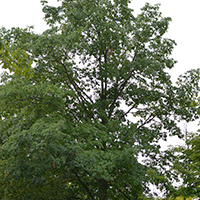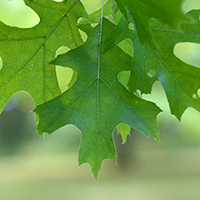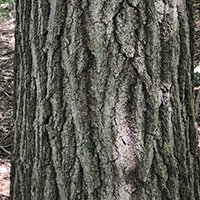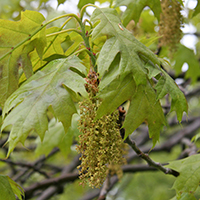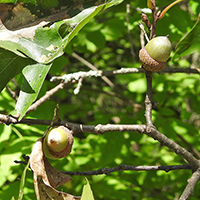What red oak looks like
Size and shape
- Reaches 20 to 30 metres high.
- Thick trunk (up to 30 to 90 centimetres in diameter).
Leaves
- Dark green (10 to 20 centimetres long).
- Leaves have sharp, pointed lobes (usually 7 to 9) with bristly tips.
Bark
- Smooth and dark grey when the tree is young.
- Deep ridges develop with age.
Flowers
- Yellow-green catkins develop in spring.
Fruit
- Acorns are round (2 to 3 centimetres long) with a scaly cap that covers less than a quarter of the acorn.
Where red oak is found
Red oak can be found east of Lake Superior and across Central and Southern Ontario.
What you need to know to grow red oak
- Moisture: tolerates a variety of moisture levels.
- Soil: grows in a variety of soils.
- Shade: grows best in full sun but can tolerate some shade.
- Cautions:
- Space: Red oak needs room to grow. It will not grow well if near other trees.
- Disease: oak wilt is caused by an invasive fungus that has been found in Southern Ontario. To minimize the risk of oak wilt, save pruning for before April and after July, when beetles thought to transport the fungus are less active.
Benefits and uses of red oak
Wildlife benefits
Red oak leaves, stems and acorns provide food for various mammals, including deer, squirrels and black bears.
Red oak also provides nesting habitat and a food source for many bird species, including turkeys, woodpeckers and grouse.
Commercial uses
Red oak wood is a popular and durable hardwood choice for woodworkers. It is commonly used in:
- cabinetry
- flooring and trim
- furniture
Red oak is also popular for ornamental and shade purposes due to its bright fall colours and tolerance for varied growing conditions.
Current research
To learn about our research on red oak, visit our science publications catalogue and search for “red oak.”
Fun facts about red oak
- Red oak trunks can sometimes reach more than 120 centimetres in diameter.
- Sometimes dead leaves stay on oak trees, even in the winter.
Updated: November 22, 2023
Published: July 18, 2014
